Rの誕生日旅行 / R's Birthday Trip
目次 / Contents
1) 境内 / Grounds
2) 大長寿院 / Daichojuin Hall
3) 釈迦堂 / Shakadō Hall
4) 白山神社 / Hakusan Shrine
A. 神社の参道 / Shrine Approach
B. 白山神社能楽殿 / Hakusan Shrine Noh Hall
C. 能舞台 / Noh Stage
D. 本殿 / Main Building
5) 表参道 / Approach
A. いくつものお堂 / Many Halls
B. 本堂 / Main Building
1) 境内 / Grounds
 |
| 中尊寺の境内 中尊寺 (チュウソンジ) は岩手県南部の平泉町にある天台宗のお寺です。 奥州藤原氏、国宝第一号の金色堂、経蔵は前回のセクションです(下記)。 ❹ - A 2019年10月17日 中尊寺;東北旅行 / Chūson-ji Temple; Tō... Chūson-ji Temple Map in Japanese Chūson-ji Temple is in the Tiantai school of Buddhism in the centre of Hiraizumi Town, southern Iwate Prefecture, Japan. 画像は下記より/ This from below★  境内 / Map in Japanese and English About Ōshū Fujiwara-shi : Northern Fujiwara and Konjikido : Golden Hall was the first National Treasure in Japan, and Kyōzō are in the previous section, below. ❹ - A 2019年10月17日 中尊寺;東北旅行 / Chūson-ji Temple; Tō... |
2) 大長寿院 / Daichojuin Hall
 |
| 中尊寺には、たくさんの大きな木があります。 その中でも、この木はちょっと変わった形です。 中心の幹がなくなってしまったのでしょうか? There are many big trees in Chūson-ji Temple. Among them, this tree has a slightly unusual shape. Did the central trunk disappear? |
下記、お寺のサイトより
"大長寿院
『吾妻鏡』によれば、二階大堂(大長寿院と号す)の高さは
五丈(約15m)、本尊は三丈(約9m)の金色の阿弥陀像、
脇には丈六(約4.8m)の阿弥陀像九躰が安置されていたと
いわれます。
1189年(文治5年)、奥州征伐の折に二階大堂を見た源頼朝は、
鎌倉に、これを模した永福寺を建て、奥州藤原氏と源義経の霊を
弔いました。
現在の本堂は、1863年(文久3年)の再建。"
源 頼朝が見た '二階大堂' は、奥州藤原氏、三代目、
藤原 秀衡 (フジワラ ノ ヒデヒラ / 1122頃 - 1187) が
無量光院の規模は、平等院よりも大きかったと推定されています。
現在、永福寺跡周辺が "二階堂"と呼ばれているのも、この建物が由来となっています。
私が英国から本帰国して、最初に住んだところが この "二階堂"でした。
"二階堂"の名前が、東北のお寺の名前であったことを今になって知りました。
下記、『吾妻鏡』について、Wikiより。
"『吾妻鏡』または『東鑑』(あずまかがみ、あづまかがみ)は、
6代の将軍記という構成で、
From the temple website below.(translation by me)
"Daichojuin Hall
According to 'Azuma Kagami',
the height of Nikaidaido Hall (called Daichojuin Hall) is about 15m,
the principal image ; Golden Amida statue is about 9m,
there were nine 4.8m Amida statues on the side.
In 1189, Minamoto no Yoritomo (1147 - 1199) saw the Nikaidaido : Nikai Great Hall, when he conquered Oshu.
Yoritomo built Youfukuji Temple in Kamakura to mourn the spirits of Ōshū Fujiwara-shi : Northern Fujiwara and his brother Minamoto no Yoshitsune (1159 - 1189).
The current Hall : Daichojuin Hall was rebuilt in 1863. "
Youfukuji Temple in Kamakura was lost due to a fire in 1405, and is now preserved as the site of Youfukuji Temple (land only).
The 'Nikaidaido Hall : Nikai Great Hall' was seen by Yoritomo which was Muryōkō-in Temple, which the third of
It is estimated that the scale of Muryōkō-in Temple, was larger than that of Byōdō-in Temple.
Today, the area around the site of Youfukuji Temple is called "Nikaido", its origin came from this building: 'Nikaidaido Hall : Nikai Great Hall'.
I came back from Britain and first lived in this "Nikaido" in Kamakura.
I now know that the name of "Nikaido" was the name of the temple in Tōhoku.
According to Wiki about Azuma Kagami ,
"Azuma Kagami (吾妻鏡/東鑑, literally, "Mirror of the East") is a Japanese historical chronicle.
The medieval text chronicles events of the Kamakura Shogunate from Minamoto no Yoritomo's rebellion against the Taira clan in Izokuni of 1180 to the 6th Shōgun, Munetaka Shinnō (1242 -1274 / reign:1252 - 1266) and his return to Kyoto in 1266."
 |
| 竹林が美しい! Bamboo Woods are beautiful! |
 |
| 立派な木 : モミ '天然記念物' Great Tree ; Fir 'Natural Monument' |
 |
| 空を見上げると.... 紅葉にはまだ早い? Looking Up at the Sky ... Is it still early for the autumn colours ? |
 |
| 特別何かあると言うわけではありませんが 良い空間に感じます。 I'm not saying there is anything special, but it feels like a good space. |
 |
| 木々の間から 金色堂旧覆堂が見えます。 I can see the Former Golden Hall Protecting Shell between the trees. |
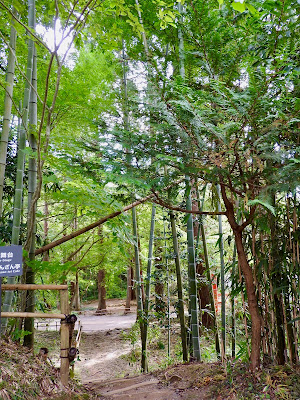 |
| 正門からでなく、ここから 大長寿院の敷地をでました。 We left the site of Daichojuin from here, not from the main gate. |
3) 釈迦堂 / Shakadō Hall
 |
| 釈迦堂 1719年の再建で本尊は 釈迦三尊 (シャカサンゾン)です。 Shakadō Hall Rebuilt in 1719, the principal image is Shaka Sanson :Shakyamuni triad.  |
4) 白山神社へ / To Hakusan Shrine
A. 神社の参道 / Shrine Approach
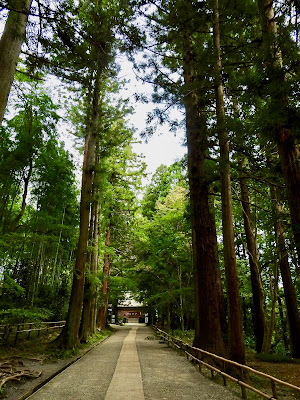 |
| 白山神社への参道 The approach to Hakusan Shrine |
 |
| 根が地表に溢れ出て、 自然の階段になっています。 The roots overflow from the surface of the earth, creating a natural staircase. |
 |
the syncretism of Shinto and Buddhism that was Japan's only organized religion up until the Meiji period. |
 |
これは巣箱??? Is this a bird box??? 火災報知器でした! It is a fire alarm! |
 |
| 参道からの弁財天堂 弁財天堂の後ろが見えます。 あとで、正面側からも見ました。 Benzaitendo Hall From the Approach I can see the back of Benzaitendo Hall. Later, I saw it from the front as well. |
 |
| 綺麗な緑 Beautiful Green 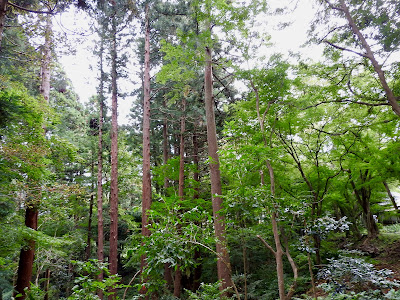 |
B. 白山神社能楽殿 / Hakusan Shrine Noh Hall
ツアーの集合時間を気にしながら、長い参道を歩き、ようやく、白山神社能楽堂に到着。
能楽堂を見ることができて、よかったです。
神に捧げる踊りや能の場所には、ピュアーな '気' があるように感じます。
ここの能楽堂の屋根が藁葺きで、優しい感じがします。
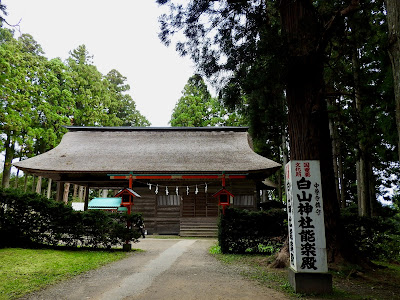 |
| 白山神社能楽殿 白山神社は、中尊寺境内の北に位置しています。 日本各地に数ある白山神社の一つで、 能楽殿は、本殿の手前にあります。 Hakusan Shrine Noh Hall Hakusan Shrine is located in the north of the precincts of Chūson-ji Temple. It is one of the many Hakusan shrines in various parts of Japan, and was once the guardian shrine of Chūson-ji Temple. The Noh Hall is before the main shrine. |
Hakusan Shrine Noh Hall
We walked a long approach while paying attention to the meeting time of the tour, and finally arrived at Hakusan Shrine Noh Stage.
It was nice to be able to see the Noh Stage.
I feel that there is a pure 'Qi' in the place of dance and Noh dedicated to God.
The roof of the Noh Hall here is thatched, and it feels gentle.
C. 能舞台 / Noh Stage
 |
| 白山神社能舞台 Hakusan Shrine Noh Stage  この能舞台は、1853年に仙台藩、13代藩主、 伊達 慶邦 (ダテ ヨシクニ / 1825 - 1874 / 在位 : 1841 - 1868) によって再建されました。 2003年に国の重要文化財に指定されています。 背景の絵は、松野 奏風 (1899 - 1963)画。 This Noh stage was rebuilt in 1853 by the Sendai domain, the 13th feudal lord, Date Yoshikuni (1825 - 1874 / reign : 1841-1868). In 2003, the Noh stage was designated as a National Important Cultural Property in Japan. The background painting is by Sofu Matsuno (1899 - 1963). |
下記、中尊寺サイトより
"古来、卯月初午の日に催行された中尊寺鎮守・白山神社の祭礼では、中尊寺一山の僧侶によって
「古実舞(古実式三番)」と「御神事能」が
神前に奉納されてきました。
現在も毎年5月4日・5日に古実式三番と神事能が中尊寺一山の僧侶によって勤められます。"
巫女や白拍子 (シラビョウシ) が踊る舞ではなく、僧侶が舞う、能舞であることが寺の中の神社の祭事であることが感じられます。
 |
| I sum up their website, below. "Since ancient times, the Shrine held on festivals, Monks have dedicated two Noh to the shrine. Even now, they do on May 4th and 5th every year." 画像は下記より / This from below ★ |
In the festivals ; sacred rites, Noh dances are by monks rather than dances performed by shrine maidens, or Shirabyōshi ; they were Japanese female entertainers in the Heian and Kamakura period who sang songs, and performed dances which makes my feeling this is a shrine inside the temple.
D. 本殿 / Main Building
 |
| 白山神社本殿 Hakusan Shrine Main Building  |
Main Building
According to Chūson-ji Temple, it is said that
Ennin [Jikaku Daishi / 794 - 864]
founded Chūson-ji Temple in 850.
It is said that this Hakusan Shrine was also solicited by Ennin from Shirayamahime Jinja Shrine in Kaga Province (now Ishikawa Prefecture) in 850.
Shirayamahime Jinja Shrine is the grand head shrine of more than 2,000 Hakusan Shrines in Japan.
 |
| 表参道へ戻ります。 Return to the main approach. |
5) 表参道 / Main Approach
A. いくつものお堂 / Many Halls
境内には、本堂、他17の院 (お堂) があります。
全てを見ることは、ツアーが与えてくれた時間内には無理です。
表参道に並ぶ、殆どのお堂は、写真撮影のみでした。
たくさんの建造物に、在りし日の奥州藤原氏の財力と繁栄を見ることができます。
また、その後も仙台藩によっても保持され、中尊寺には良い運があるように感じられます。
私を含め多くの来訪者が宗教的な信仰を強く持たなくとも、尊敬の気持ちを持って見て回ることが、ここの特別な空気を維持させているのだと思いました。
また、信仰も尊敬も持たない人の来訪でも、そのエネルギーが役に立っているのではないかと思います。
悲しいことは忘れ去られて放置されてしまうことだと思うので.....。
Many Halls
There are a main hall and 17 other temples in the precincts.
Seeing everything is not possible within the time the tour has given us.
I could only photograph most of the halls along the main approach : Omotesando.
I can see the financial strength and prosperity of the Northern Fujiwara in their many buildings.
Here was also retained by the Sendai Domain after that, and it seems that Chūson-ji Temple has good luck.
Even if many visitors, including myself, do not have a strong religious belief, I think that looking around here with respect keeps the special atmosphere here.
I also think that even though the visitors have neither faith nor respect, they bring their energy.
In my view it is important that here is never forgotten, it would be a sad thing if this temple is forgotten and left neglected.
讃衡蔵 / Museum
 |
| 奥州藤原氏の残した文化財3000点あまりを 収蔵・展示しています。 有料です。(拝観料 金色堂・讃衡蔵共通) ツアーからチケットをもらっていたので、 入館しました。 足早に見ました。 元々は、各お堂に安置されていた像はここに集められています。 Here shows or stores more then 3000 cultural properties which were left by the Northern Fujiwara. There is a charge. (Admission fee common to Konjikido : Golden Hall and Sankozo : Museum) We got a ticket from our tour, so we entered the museum. I looked quickly. The statues that were originally enshrined in various halls are collected here. 画像は下記より / This from below ★ |
弁財天堂 / Benzaitendo Hall
 |
  Benzaiten (or Benten) is a Japanese Buddhist goddess who originated from the Hindu goddess Saraswati. |
 |
| 木々を見つつ下山します。 Go down the mountain while looking at the trees. |
 |
峯薬師堂 |
不動堂 / Fudōdō Hall
 |
不動堂 本堂近くの不動堂は、1977年建立の祈祷堂です。 御本尊の不動明王 (フドウミョウオウ) は 1684年、仙台藩、3代藩主、 伊達 綱村 (ダテ ツナムラ / 1659 -1719) により天下泰平を祈願し新調されました。 Fudōdō Hall Fudōdō Hall near the main building is a prayer hall built in 1977. In 1684, the lord of the Sendai Domain, Date Tsunamura (1659 -1719) , prayed for Taihei Tenka and was renewed. |
不動明王像は日本各地にある像のように感じます。
力で平和を成り立たせたり、苦しむ人々を救うので怖い表情の像が多いと思いますが、人々は、”お不動さん"と呼び、親しんでいます。
About Fudō Myōō
It is also the centre of the Five Great Myo Kings.
The statue of Fudō Myōō feels like other statues in various parts of Japan.
I think that there are many images of scary appearance because he makes peace with power and saves those who suffer, however, people call him "Fudo-san", casually and they feel familiar with him.
B. 本堂 / Main Building
 |
| 本堂の脇の門 The side gate of the main building |
 |
本堂 / Main building  |
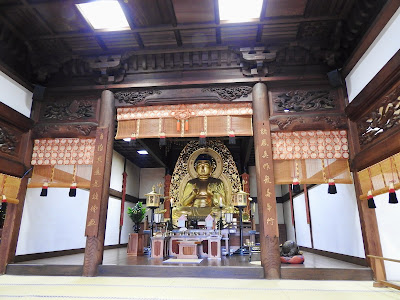 |
| 内部 / Inside |
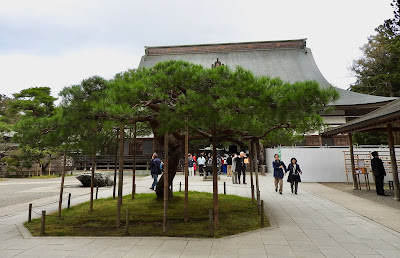 |
| Rはこの松を気に入っていました。 R liked this pine. |
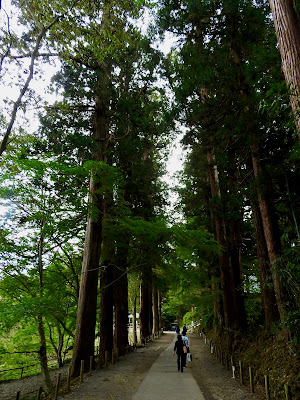 |
| 月見坂 もうすぐ、中尊寺を離れます。 Tsukimi Hill : Looking At The Moon Hill We will leave Chūson-ji Temple soon. |
月見坂
中尊寺は標高130メートルほどの東西に長い丘陵に位置しているため、この坂が古くから本堂・金色堂へと参拝する人々の表参道として利用されてきました。
参道をのぼり始めると、両脇には江戸時代に伊達藩によって植樹された樹齢300年を数えようかという幾本もの老杉が木陰を作ります。
敷地が広い観光地に来ると、ツアーの決められた時間が辛いです。
中尊寺はもう少しゆっくりと見たかったですね。
Tsukimi Hill : Looking At The Moon Hill
Chūson-ji Temple is located on a long hill from east to west at an altitude of about 130 m, so this slope has long been used as an Omotesando : main approach for people who worship at the main hall and Konjikido : Golden Hall.
When you start climbing the approach, a number of old cedar trees planted by Sendai Domain in the Edo period shade the trees on both sides.
When I come to a tourist spot with a large site, the fixed time for the tour is difficult.
I wanted to see Chūson-ji Temple a little more slowly.



















0 件のコメント:
コメントを投稿